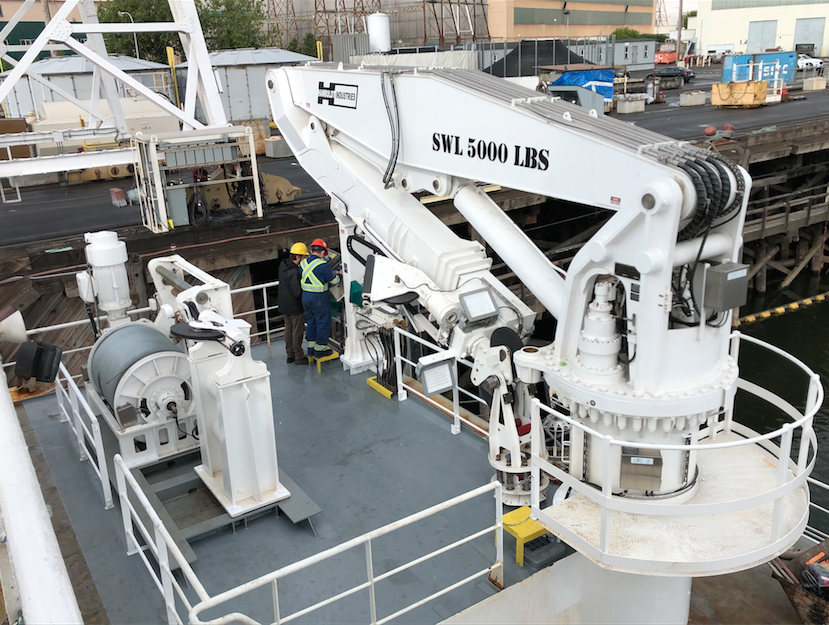Hawboldt Industries has installed an ABB winch drive with unique inbuilt active heave compensation (AHC) software at the heart of a new winch and offshore crane for the Research Vessel Kilo Moana.
The enhanced winch control provides University of Hawai‘i Marine Center scientists with a safe, efficient and reliable way of deploying water sampling equipment at depths up to 5,000 meters in even the roughest sea conditions.
The Kilo Moana is a 60-meter Small Waterplane Area Twin Hull (SWATH) ship owned by the US Navy and operated by the University of Hawai‘i Marine Center. This oceanographic research vessel enables scientists to conduct tests that increase their understanding of the effect of deep ocean currents on marine life and climate change.
One of the vessel’s main activities is to carry out conductivity, temperature and dissolved oxygen (CTD) ‘casts’ at depths of up to 5,000 meters in the mid-Pacific Ocean. During a cast, the CTD package, weighing around 900 kilograms, is lowered from the deck of the ship into the water. In addition to sensitive pressure and temperature sensors, the package includes 24 bottles that collect water samples at various depths.
In 2019, the University of Hawai‘i Marine Center decided to upgrade the Kilo Moana’s CTD Launch and Recovery System (LARS) to a new design with active heave compensation (AHC). This system takes information on wave action from the vessel’s motion reference unit (MRU) and adjusts the winch motors to compensate. The precise adjustments in winch tension – made hundreds of times per second - keep the package steady in relation to the seabed as the vessel pitches up and down.
 ABB ACS880 drive with Integral AHC
ABB ACS880 drive with Integral AHC
ABB supplied the ACS880 winch drive to Hawboldt Industries, the Canadian company that specialises in the custom design and manufacture of deck equipment for ocean science vessels. According to Dylan Wells, General Manager of Hawboldt Industries, AHC is essential in UH’s CTD operations, minimizing cable tension spikes, and allowing the package to take samples safely and reliably. It’s especially critical in rough conditions when waves can be as high as four meters and there are significant vessel roll, pitch, and heave motions.
The AHC also allows for a faster yet more controlled deployment by keeping a more consistent cable tension and thereby eliminating slack conditions as well as the tension spikes. A slack cable can get hockled (tied in knots) which can result in major damage requiring replacement of the long cable, meaning high costs for replacement equipment and lost ship time.
“A winch drive is an integral element in our equipment and the ABB ACS880 drive is unique because it comes with AHC functionality built in as firmware,” said Wells. “Therefore, we didn’t need to change the system architecture or deal with the cost and complexity of installing an external, third-party AHC control system. With the ABB drive all we needed to do was to connect it to the MRU and switch it on.”
CTD cast times cut by around 30 percent
The Kilo Moana undertook successful sea trials of the CTD crane and winch in early 2020. The trials confirmed that the AHC performed well in reducing the snap loading on the winch cable, with fast response and smooth transitions. An added bonus is that it also enables scientists to carry out more precise water sampling, with depths controlled to a resolution of one meter at depths up to 5 kilometers.
Cast times are also reduced significantly. The time for each cast – from deployment to recovery – has been cut from 45 minutes to 30 minutes. This is important as the Kilo Moana may often perform up to five casts per day. With the new Hawboldt system it can reach 60 meters per minute average payout speed – while the actual cable speed at the winch varies from 0 to 130 meters per minute according to the sea state.
Scientists approve the new CTD system
The Kilo Moana spends between 200 to 250 days at sea with operations from a few days up to a month. One of its most regular missions is the Hawaii Ocean Time-series (HOT) cruise that has been making repeated observations at a station north of Oahu since October 1988. The aim is to monitor the carbon dioxide (CO2) content of the seawater as a measure of the progress of climate change.
For Scott Ferguson, University of Hawai‘i Director for Marine Technical Service, the new CTD winch and crane has offered real benefits.
“Taking CTD samples is a primary element for the Kilo Moana with a cost of around $50,000 to run each day at sea,” said Ferguson. “If we can’t work because the sea is too rough then we face a major loss of revenue. The advantage of our new crane with AHC is that it enables CTD casting to be carried out with safety and precision even when waves are 4 meters high. That’s why our scientists love it. While our deck crew appreciates it because of its reliability and ease of operation.”
For more information on active heave control for winches, click here.





